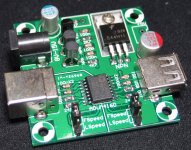I'm a novice, so please forgive me if I say something stupid.
I have a couple of questions concerning the use of what appears to be a NPN BJT as a replacement for a NPN linear regulator on a ADuM4160 USB isolator board. The NPN part supplies power to the downstream side of the ADuM4160 isolator chip and the connected USB device. This application is for USB audio and audiophile purposes. Most of the ADuM4160 USB isolation boards use switch mode DC-DC converters in place of the parts I mentioned above. Manufacturers of the USB isolation boards made specifically for audio purposes have deliberately stayed away from simple switch mode components to make them more electrically quiet.
My questions: Is a NPN BJT a better, more quiet option than a NPN linear regulator that may not be particularly quiet by spec? The linear regulator it replaced was a 1038. What if this section of the board is supplied by a linear regulated PSU? I understand the BJT has a very fast switch rate that may be a high enough frequency that any noise it may produce is outside a range that may be detrimental to downstream digital equipment (USB audio devices powered from the USB connection).

I ask because one of the Chinese audio manufacturers USB isolation boards (pic) was recently changed as I describe above. The seller (not the manufacturer) is selling the device with information for the old specifications and doesn't understand the differences of the revised board. I've sent messages to the manufacturer and the seller about the changes and neither have replied. It seems convenient for customers from the other side of the planet to cease to exist when things aren't cool for some Chinese web vendors. Kind of a pathetic way to do business and makes dealing with them a gamble much of the time. It's been my experience that even the Chinese vendors that prove somewhat dependable can go silent when problems develop that they don't want to deal with.
Thanks for your time.
I have a couple of questions concerning the use of what appears to be a NPN BJT as a replacement for a NPN linear regulator on a ADuM4160 USB isolator board. The NPN part supplies power to the downstream side of the ADuM4160 isolator chip and the connected USB device. This application is for USB audio and audiophile purposes. Most of the ADuM4160 USB isolation boards use switch mode DC-DC converters in place of the parts I mentioned above. Manufacturers of the USB isolation boards made specifically for audio purposes have deliberately stayed away from simple switch mode components to make them more electrically quiet.
My questions: Is a NPN BJT a better, more quiet option than a NPN linear regulator that may not be particularly quiet by spec? The linear regulator it replaced was a 1038. What if this section of the board is supplied by a linear regulated PSU? I understand the BJT has a very fast switch rate that may be a high enough frequency that any noise it may produce is outside a range that may be detrimental to downstream digital equipment (USB audio devices powered from the USB connection).

I ask because one of the Chinese audio manufacturers USB isolation boards (pic) was recently changed as I describe above. The seller (not the manufacturer) is selling the device with information for the old specifications and doesn't understand the differences of the revised board. I've sent messages to the manufacturer and the seller about the changes and neither have replied. It seems convenient for customers from the other side of the planet to cease to exist when things aren't cool for some Chinese web vendors. Kind of a pathetic way to do business and makes dealing with them a gamble much of the time. It's been my experience that even the Chinese vendors that prove somewhat dependable can go silent when problems develop that they don't want to deal with.
Thanks for your time.
If you get the option for an LM317/LM337 regulator, they are superior to 78XX/79XX series regulators.
If you get the option for an LM317/LM337 regulator, they are superior to 78XX/79XX series regulators.
I have DIY Paradise Ultravox ADuM4160 that uses an LM317T. It's my first choice of any ADuM4160 boards made for USB audio. That has nothing to do with the OP, though. Thanks.
Hi,
The transistor has not replaced a regulator. Its a boost
pass transistor for the TO92 regulator on the board.
rgds, sreten.
The transistor has not replaced a regulator. Its a boost
pass transistor for the TO92 regulator on the board.
rgds, sreten.
Hi,
The transistor has not replaced a regulator. Its a boost
pass transistor for the TO92 regulator on the board.
rgds, sreten.
Thank you for steering me to a better understanding. I now see that the original part was a BJT MJE15030. I was looking at the wrong spec. This makes more sense. There is still a question of the fast switch rate is of high enough frequency to be outside a range that will have an effect on downstream digital audio devices. I expect it is much better than the reference board that most manufacturers follow.
The design of this ADuM4160 board is different from the others I've seen. The DIY Paradise Ultravox uses a LM317T linear regulator beside a C550C.
- Status
- Not open for further replies.